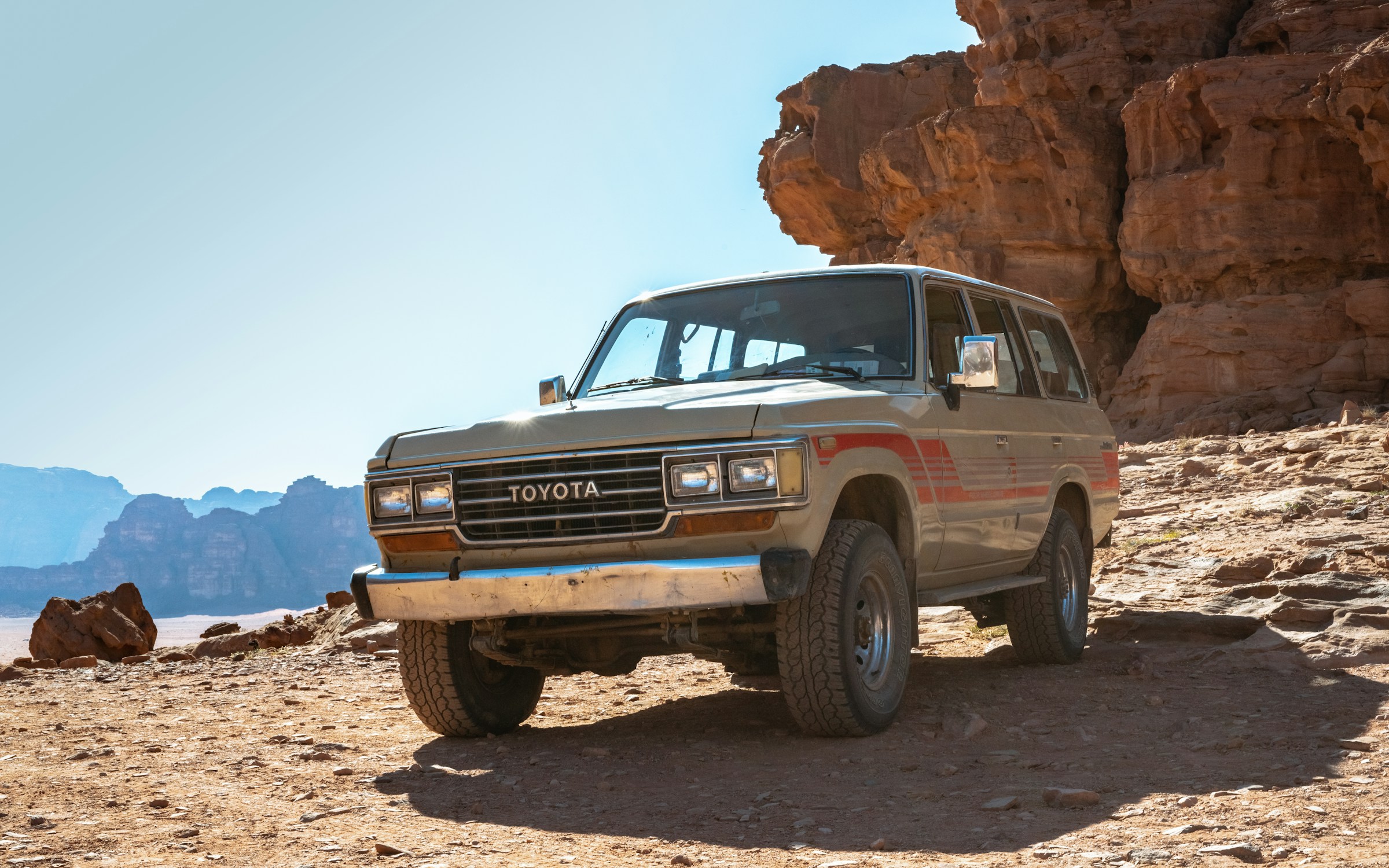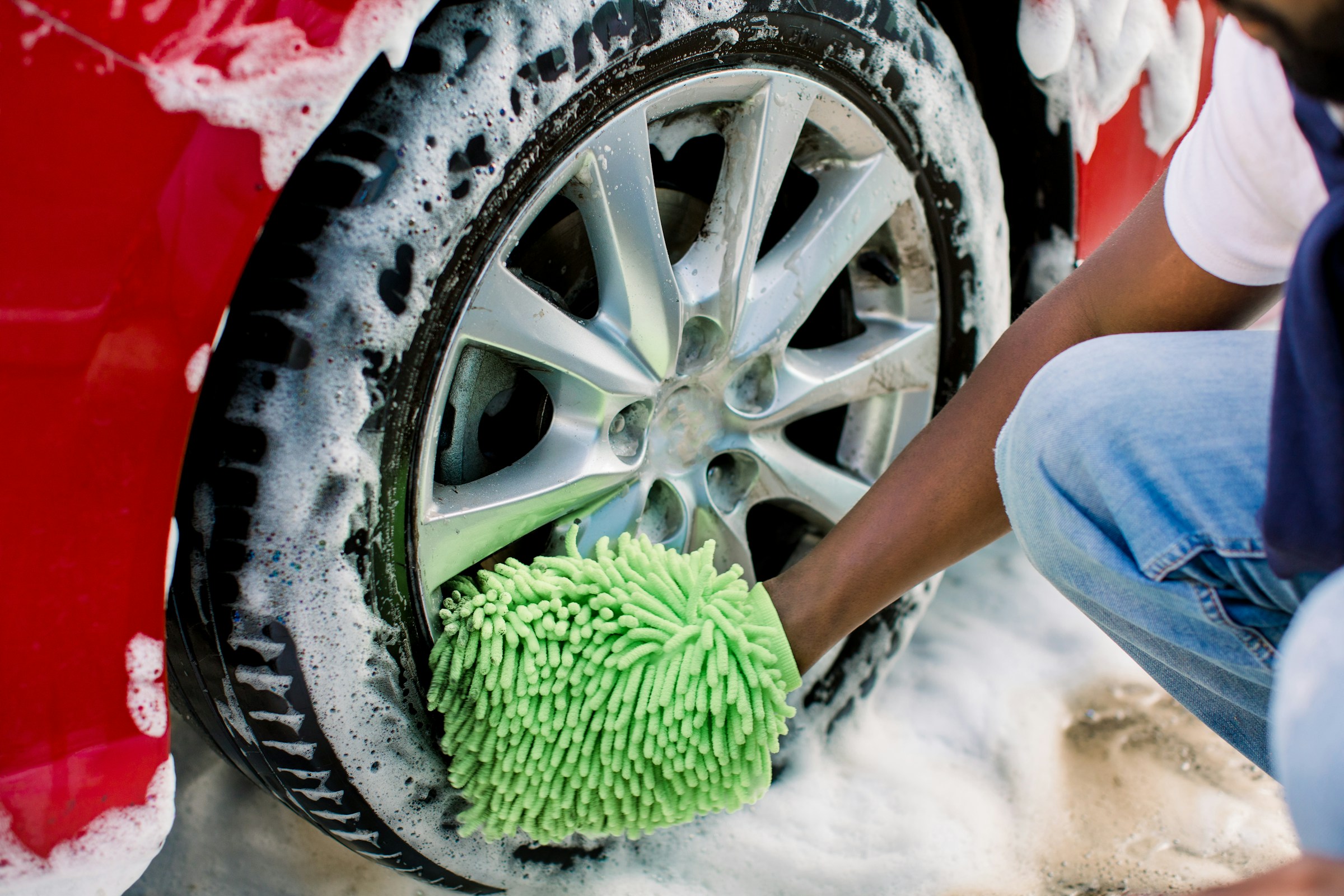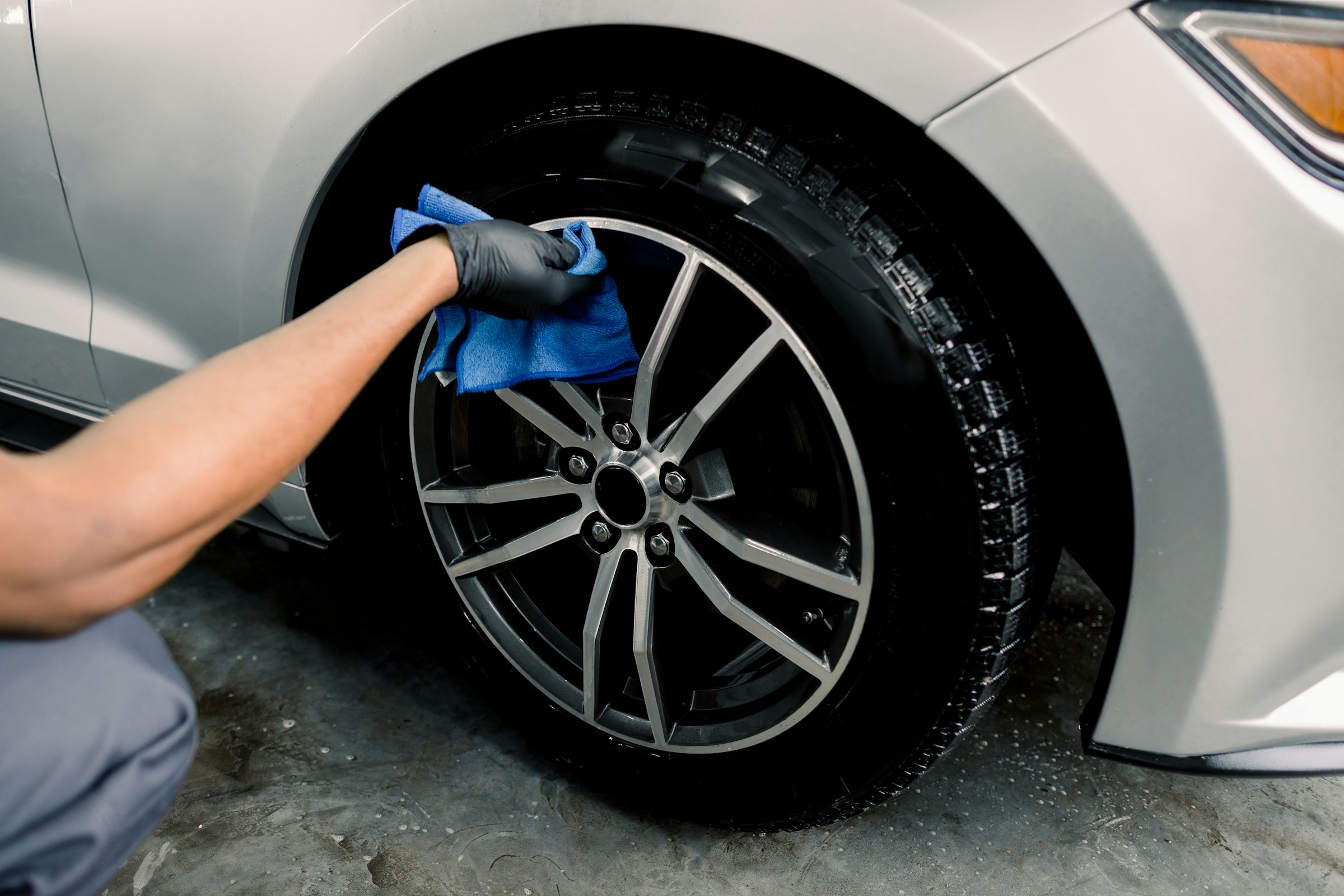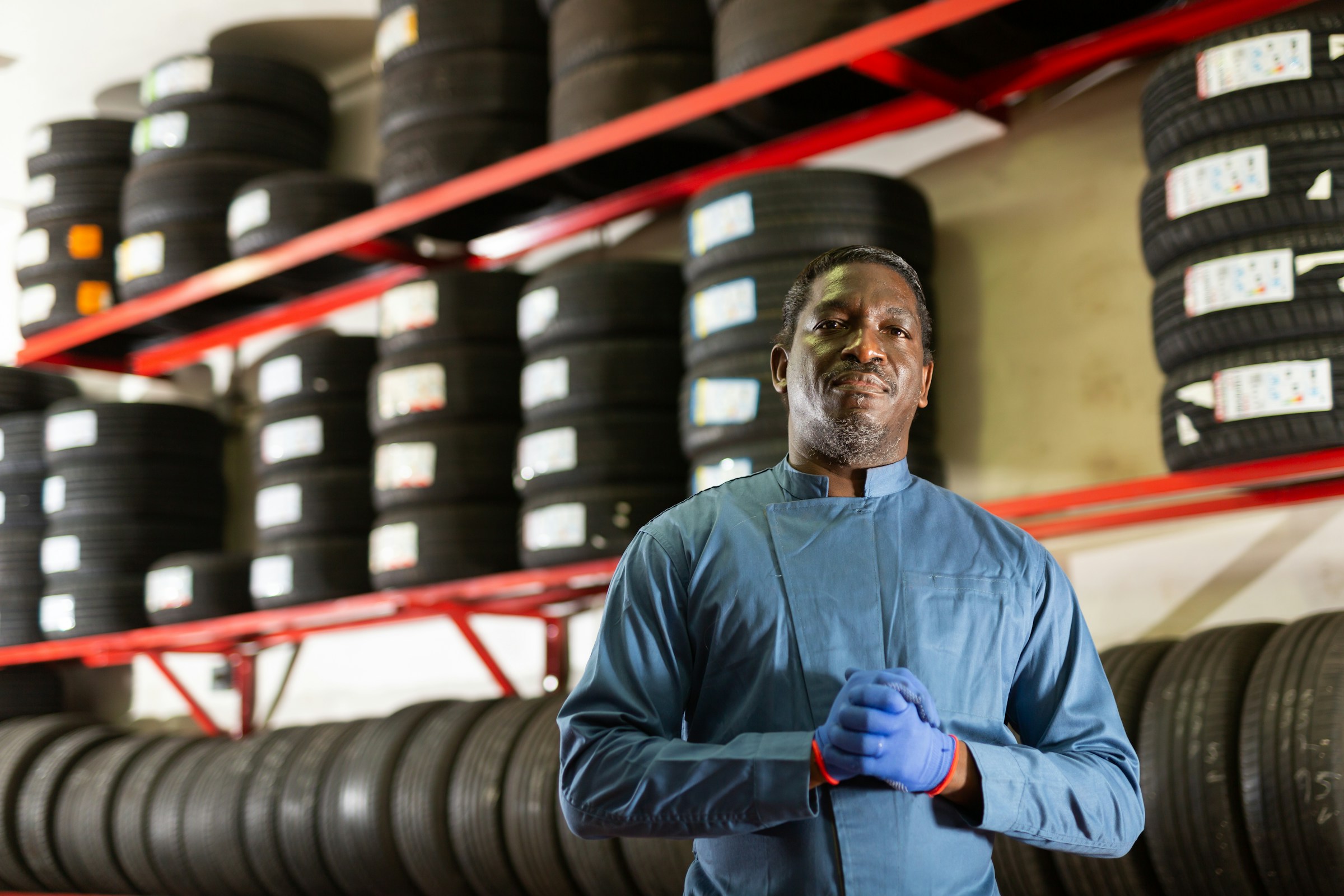If you’ve ever wondered what causes tires to turn brown – the science has a few nuances. Tires that gradually shift from deep black to dull chocolate-brown are not failing, they are “blooming.”
Brown sidewalls are produced when protective antiozonant chemicals inside the rubber migrate to the surface and oxidize. Although visually unappealing, blooming shows the tire’s self-preservation system is working. Consistent cleaning, dedicated rubber cleaners, and modern water-based dressings keep sidewalls dark while avoiding sling or long-term damage.

The Science of Tire “Bloom”: Antiozonants and 6PPD
Manufacturers blend antiozonants, most commonly N-(1,3-dimethylbutyl)-N’-phenyl-p-phenylenediamine (6PPD), into sidewall compounds to fight ozone cracks and UV degradation.
As a tire flexes, microscopic pores open, allowing 6PPD to migrate (“bloom”) to the surface where it sacrificially reacts with oxygen and ozone, forming a brown residue called 6PPD-quinone.
Blooming accelerates when tires sit unused, are stored near ozone sources (electric motors, welders), or when solvent-heavy dressings trap residues on the surface.
Evaluating Your Browning Tires
| Visual Check | Appearance | Cause | Potential Concern |
|---|---|---|---|
| Light bronze haze | Even film over entire sidewall | Early-stage oxidation of 6PPD | Cosmetic only |
| Dark streaks | Concentrated near raised lettering or curb rash | Surface abrasion draws more antiozonant | Mask underlying cuts; inspect closely |
| Persistent matte brown | Returns within days of washing | Heavy bloom layer + trapped dirt | Requires deep rubber cleaner |
Does Browning Harm the Tire?
Antiozonants extend service life; the brown layer is evidence of protection rather than deterioration.
Internal rubber compounds remain pliable because blooming is confined to the outer microns of the sidewall.
So when should you worry? Cracking, bulges, or cords showing through the brown layer signal age or impact damage. Replace your tires immediately.
Cleaning vs. Dressing

Step 1: Deep-Clean the Rubber
- Use a dedicated tire/rubber cleaner marketed for bloom removal. Products include P&S Undressed, Adam’s Wheel & Tire Cleaner, CarPro ReTyre, or Tuf Shine Tire Cleaner.
- Agitate with a stiff nylon tire brush; rinse until foam turns white, indicating residue removal.
- Avoid aggressive degreasers or bleach unless recommended on raised-white-letter tires; they can dry sidewalls and worsen bloom long-term.
Step 2: Apply a Water-Based Dressing or Coating

| Product Type | Shine Level | Longevity | Bloom Resistance |
|---|---|---|---|
| Water-based silicone emulsion (CarPro Perl 1:3) | Satin | 2-3 weeks | High |
| Acrylic tire coatings (Tuf Shine Clearcoat) | Low-gloss | 4-6 months | Very high |
| Don’t Use: Solvent-based high-gloss gels | Glossy | 1-2 weeks | Poor; can trap antiozonant |
Pro detailers on report best results with satin, water-based formulas that cure dry to the touch and resist sling. Sling is when product gets slung off tires and onto the paint of the vehicle from driving.
Routine Maintenance Schedule
| Frequency | Action | Purpose |
|---|---|---|
| Every wash (2-4 weeks) | Quick scrub with car-shampoo suds & soft tire brush | Removes road film before it binds with blooming |
| Every 2-3 washes | Dedicated tire cleaner + deeper agitation | Strips oxidized antiozonant |
| Every 2-3 months | Re-apply dressing or tire coating | UV protection & hydrophobic barrier |
| Seasonal storage | Store tires in airtight bags, cool/dry area | Slows antiozonant migration |
Products That Help Slow Browning
- Rubber-Specific Cleaners – P&S Undressed, CarPro ReTyre, Griot’s Rubber Cleaner break down 6PPD residue without harsh solvents.
- Modern Dressings – Water-based gels (Gyeon Q² Tire, Koch-Chemie Gummifix) nourish rubber and shed grime.
- Tire Coatings – Semi-permanent acrylics like Tuf Shine or Gtechniq T1 create a cured film that reduces oxygen contact.
- Ozone-Free Storage Covers – Simple polyethylene bags or UV-blocking tire totes cut ozone exposure during off-season parking.
Environmental Impact of 6PPD-Quinone
- 6PPD-Q has aquatic toxicity, acutely lethal to coho salmon at concentrations as low as 0.08 µg/L, causing blood-brain barrier collapse.
- Urban stormwater runoff conveys tire-derived particles and dissolved 6PPD-Q into surface waters, triggering “Urban Runoff Mortality Syndrome” in Pacific Northwest streams.
Regulatory Momentum
| Region | Status | Action |
|---|---|---|
| California | 2023 Priority Product profile lists 6PPD in tires for potential restriction. | Investigating safer substitutes |
| Washington State | Legislative directive to DOT to pilot filtration systems capturing tire wear particulates. | Storm-drain retrofit grants |
| European Union | REACH review initiated; proposals for 6PPD alternative additives under evaluation. | Industrial R&D funding |
Consumer Choices
- Water-based dressings minimize petroleum runoff and avoid solvent leaching compared with old high-VOC formulations.
- Regular cleaning removes surface 6PPD-Q before heavy rains wash it into drains.
- Low-rolling-resistance tires reduce tread wear particle output over the tire’s life.
Myth-Busting
| Myth | Reality |
|---|---|
| “Silicone tire shines cause browning.” | Silicone itself doesn’t oxidize brown; it can trap antiozonant on the surface if over-applied, accelerating visible bloom. |
| “Bleach White removes bloom safely.” | Modern formulas are weaker; overspray can corrode uncoated aluminum. Use with caution and rinse thoroughly. |
| “New tires won’t brown.” | All passenger tires containing 6PPD will bloom eventually, regardless of brand or price tier. |
| “Browning means the tire is unsafe.” | Bloom is cosmetic; check tread depth and age (DOT code) for true serviceability. |
Sustainable Innovations

- Next-Gen Antiozonants
Polymer-bound amine stabilizers that do not transform into toxic quinones are under laboratory testing. - Particle-Capture Pavement
Porous asphalt and vegetated biofilters inside curb inlets can trap tire wear particles before they reach waterways. - Vehicle Tech
Regenerative braking and lower curb-weight EV platforms reduce abrasive forces and particulate emission relative to traditional friction-brake vehicles.
Tire browning is a visible side effect of an essential protective chemistry. By combining routine deep-cleaning, modern water-based dressings, and conscientious storage, enthusiasts can keep their sidewalls rich black without compromising rubber health or local waterways.
As regulators scrutinize 6PPD-quinone and researchers pursue greener additives, simple garage habits including cleaning before storms, choosing low-VOC products, and maintaining proper tire pressure to cut wear, remain the most practical tools in the fight against the brown bloom.
Article Last Updated: October 13, 2025.
